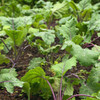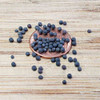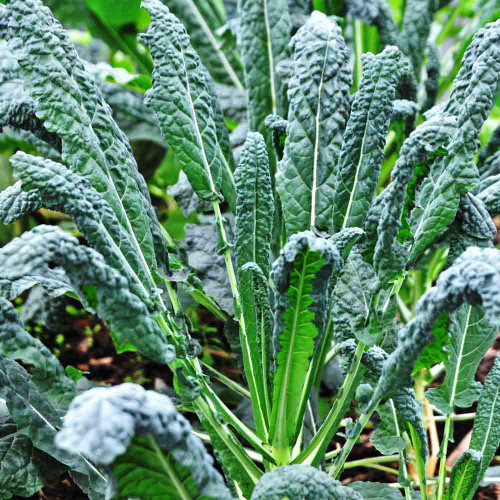Red Russian Kale Seeds - (Brassica napus var. pabularia)
- SKU:
- V1052
- Seed Count:
- Approx 200 seeds per pack
- Days to Maturity:
- 50-65 days
- Days to Germination:
- 5-10 days @ 65-85F
- Plant Spacing:
- 12-24"
- Light Preference:
- Full sun to partial shade depending on time of year
- Status:
- Heirloom, Non-Hybrid, Non-GMO seeds
Description
Red-Russian Kale - The Most Versatile Green in Your Garden
I remember when we first planted Red Russian kale, as it was different from the others we had grown before - bigger, oak-shaped leaves, and very vigorous. We direct-sowed it in early spring, and it was well established when the heat of our Arizona June arrived. That same plant grew through the summer heat and deep into the mid-winter, producing through frosts and only slowing during the hardest freezes. This remarkable resilience was matched by a flavor that was richer and deeper than any other kale we had tasted. It was never bitter and held up beautifully in cooking, anchoring summer pasta sauces with its deep, slightly sweet foundation.
Details
Red Russian Kale is a classic heirloom renowned for its superior tenderness, mild flavor, and exceptional cold hardiness derived from its Siberian lineage. In a surprising display of resilience, we've found it also tolerates summer heat far better than many other kales, resisting bitterness and providing a much wider harvest window. Its proper botanical classification, Brassica napus var. pabularia, is the genetic key to these defining traits—a result of a natural cross between wild cabbage and turnip ancestors that gives it a resilience legendary among gardeners.
In the garden, the plant grows upright, forming a loose rosette of flat, oak-leaf-shaped leaves with frilly, "ragged" margins. The foliage is a beautiful slate-gray or blue-green, with rich purple-red stems and veins that become dramatically more vibrant in cold weather, deepening to a striking reddish-purple after a frost.
Flavor is this kale’s most defining quality. It’s consistently described as mild, nutty, and subtly sweet, in contrast to the sometimes bitter notes of common curly kales. We've found this notable taste is enhanced by cold, which triggers the plant to convert starches into sugars, resulting in a significantly richer flavor after the first frosts of autumn. It’s a hardy biennial, typically grown as an annual for its leaves, but when overwintered, a mature plant can take on a striking, almost palm-like appearance with a thick central stalk topped by a cluster of new growth.
History
The story of Red Russian Kale is one of ancient origins and continental journeys. While ancient Greeks and Romans cultivated its parent species, the specific story of this variety begins in Siberia. It was introduced to North America via Canada, brought by "Russian traders" in the latter half of the 19th century. While the exact date is debated, historical records confirm its presence by at least 1863, where it was noted under synonyms like 'Ragged Jack', which was noted by the famed French seedsmen Vilmorin-Andrieux, and 'Buda Kale', as described by Fearing Burr in his 1863 Field and Garden Vegetables of America. It is highly plausible that its introduction is linked to the migration of the Doukhobors, Russian pacifists renowned for their agricultural skill who sought refuge and built new lives farming the harsh Canadian prairies starting in the late 1800s. This variety has been kept alive not by large-scale commercial breeding but by the dedicated work of seed savers and homesteaders who recognized its superior flavor and hardiness over generations as it earned its place in the home garden.
Uses
Prized for its mild flavor and tender texture, Red Russian Kale is remarkably versatile in the kitchen. Its superior tenderness makes it one of the best kale varieties for eating raw; we enjoy the baby leaves in salads, and find that even mature leaves can be finely sliced without bitterness. When cooked, the leaves become exceptionally soft and sweet, perfect for wilting into pastas, adding to soups, stews, and egg-based dishes, or baking into crispy chips. It is important to note that the thick, fibrous stems should be removed before cooking, and the beautiful reddish-purple leaves will turn a uniform green when heated. Its striking appearance also makes it a popular choice for ornamental plantings, adding texture and deep color to your edible landscape.
Companion Planting
In your garden's ecosystem, Red Russian Kale benefits from strategic companionship. Planting aromatic herbs like dill, cilantro, sage, and rosemary nearby can confuse pests like the cabbage moth with their strong scents. When these herbs flower, they attract beneficial insects like parasitic wasps and hoverflies, which prey on aphids and caterpillars. Alliums such as onions and garlic are also excellent partners, as their pungent odor can repel aphids and cabbage loopers.
It is generally advised to avoid planting it near other brassicas to prevent a concentration of shared pests, or next to strawberries, which can attract slugs.
Planting and Growing Tips
Red Russian Kale is a vigorous and adaptable cool-season crop that thrives in fertile, well-drained soil with full sun to partial shade. In climates with very hot summers, a spot with afternoon shade is helpful. For a spring harvest, you can sow seeds about two weeks before your last frost. For a superior fall and winter crop, it's best to sow seeds directly in the garden in mid-to-late summer at a depth of ¼ to ½ inch, about 10-12 weeks before your first fall frost.
Space your seeds about 12 to 24 inches apart to ensure good air circulation. Provide consistent soil moisture to ensure tender leaves. Seeds germinate reliably and quickly, typically within 5 to 14 days, in soil temperatures between 65°F and 85°F.
Its hardiness allows for different strategies based on your climate. In cold climates (Zones 3-7), it excels as a fall crop that can be harvested from under the snow and can often be overwintered with a thick layer of mulch. In warmer regions (Zones 8-12), it's best treated as a fall, winter, and early spring crop. It also adapts remarkably well to container gardening; a 5-gallon pot is ideal for a single, thriving plant, but you'll need to be vigilant with watering as containers can dry out quickly.
Harvesting Tips
You can begin harvesting leaves once the plant is established, typically 50-60 days from sowing, using a "cut-and-come-again" method. We always harvest the oldest, outermost leaves by cutting the stem close to the main stalk, which encourages the plant to produce new growth from its center. For the best quality, harvest in the cool of the early morning. To store, wrap the unwashed bunch loosely in paper towels and place it in a sealed container in the refrigerator, where it will keep for up to a week.
Learn More
From the soil to the seed to the food you eat - we'll help you grow your best garden!

















